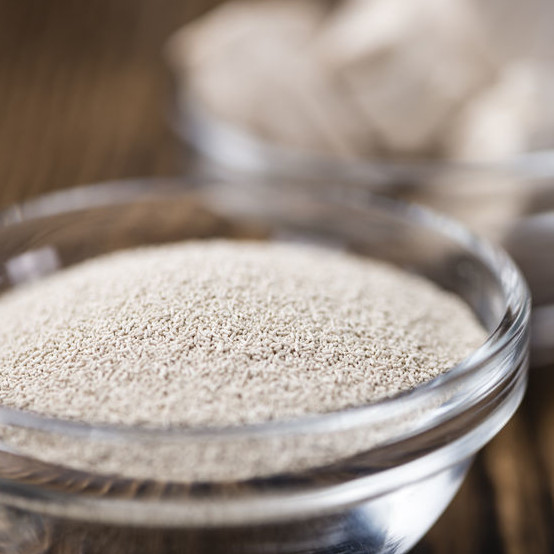
Osmotolerant Yeast
Also known as Osmophilic yeast, blue yeast or high sugar tolerant yeast
What is Osmotolerant Yeast?
Osmotolerant yeasts are strains capable of surviving and growing in high osmotic concentrations. High sugar or salt concentrations can reduce the availability of water, thus impeding regular yeast fermentation and growth. Examples of doughs that can benefit from osmotolerant Saccharomyces cerevisiae yeast include donuts, brioche and bread rolls.1
Osmotolerant yeast can be commercially found as:
- Baker’s compressed yeast
- Active dry yeast
- Instant yeast
Origin
Improving osmotolerance of yeasts relies on ways for accumulating osmoprotectants within yeast cells. Osmoprotectant salts are typically added during the later steps of dry yeast manufacture to improve its osmotolerance although can lower biomass yields.
Function
Similar to regular yeast, osmotolerant yeast can perform these functions in rich doughs:1
- Dough rising: leavening and production of carbon dioxide.
- Acidification: reducing pH, a result of production of carbon dioxide and organic acids.
- Flavor and aroma: flavor compounds produced during fermentation can impart characteristic flavor and aroma to baked goods.
- Dough conditioning: some fermentation products act as dough conditioners and increase dough extensibility by gluten relaxation.
Nutrition
Typical dry osmotolerant yeast nutritional value per 100 g:2
[fusion_table fusion_table_type=”1″ fusion_table_rows=”” fusion_table_columns=”” hide_on_mobile=”small-visibility,medium-visibility,large-visibility” class=”” id=”” animation_type=”” animation_direction=”left” animation_speed=”0.3″ animation_offset=””]
| Component | Grams |
|---|---|
| Protein | 44 |
| Carbohydrate | 39 |
| Fat | 6 |
| Water | 11 |
[/fusion_table]
Generally, S. cerevisiae yeast is a good source of vitamins D and B as well as minerals such as potassium and zinc. These nutrients are associated with health benefits like lowering cholesterol, and managing neurological and cardiovascular disorders.
Commercial production
Commercial osmotolerant dry yeast is obtained through the following process:3
- Conditioning: molasses is conditioned for its use as food for yeast propagation.
- Multiplication and maturing: yeast cells are added to molasses and placed in a series of containers. Nitrogen is removed and supply of molasses is increased at 29 – 34 oC (84.2 – 93.2 oF ). Incremental levels (0.3 – 1.0%) of salts such as NaCl, KCl, CaCl2, MgCl2, Na2SO4, MgSO4, and K2SO4 are added to improve yeast osmotic tolerance.
- Separation: yeast cells are separated from wort using centrifugation for cream recovery.
- Drying: the yeast cream is dried to appropriate moisture using a vacuum drier.
- Packaging: dried yeast pellets are packaged in 125- 500 g sachets, or 10 kg packets.
Application
Osmotolerant yeast is commonly used in rich doughs, high sugar or salt , such as croissant, brioche and sweet breads, doughnuts, danish pastry and coffee cakes. Osmophilic yeasts are commonly used in frozen doughs.1
Osmotolerant yeast can perform well at: 2
- Sugar content above 5% and as high as 25%.
- Salt content between 2 – 2.5%.
- Low water activity systems.
Advantages of using osmotolerant yeast: 4
- Provides around 10 – 20% more activity in rich doughs than its non-osmotolerant counterparts.
- Provides uniform fermentation though the whole baking process.
- imparts a higher resistance to preservatives.
- Provides higher tolerance to high baking temperatures.
- Improves machinability.
- Reduces mixing time by 10-30% compared to compressed yeast.
Considerations when working with osmotolerant yeast: 4
- Osmotolerant yeast usage level is between 1 – 3% in baker’s percentage.
- Mix osmotolerant yeast with flour or during the initial stages of mixing.
- Avoid direct contact with ice cold water.
- Increase dough temperature around 1.5 – 2.5 oC (3 – 5 oF) for optimum fermentation level.
Osmotolerant yeast can be substituted through the following guidelines:2
- This yeast can be substituted with regular active dry yeast by increasing the usage level up to 7 – 10% of the flour weight.
- Instant dry yeast may perform similarly to osmotolerant yeast if dissolved in warm water before usage.
Regulations
Three dried yeast varieties (Saccharomyces cerevisiae, Saccharomyces fragilis and Candida utilis) are permitted for direct addition to food products by the FDA.5
In the EU, the production of organic yeast is regulated by the EU Commission 1254/2008.6
References
- Figoni, P. How Baking Works: Exploring The Fundamentals Of Baking Science. 2nd ed., John Wiley & Sons, Inc., 2008.
- Reed, G . Yeast technology. 2 nd edition. Springer Science & Business Media, 1991.
- Chen, S. L., and Gutmanis,F. “Process for the production of osmotolerant yeast.” U.S. Patent No. 4,420,563. 13 Dec. 1983.
- Lesaffre et Compagnie. SAF Instant Gold. Available at https://lesaffreyeast.com/wp-content/uploads/2016/08/POS-15910-35150-35105-Saf-Instant-Gold-3-20-v2.pdf . Accessed 07 December 2020.
- U.S. Department of Health and Human Services.” Food Additives Permitted For Direct Addition To Food For Human Consumption.Title 21 Code of Federal Regulation, Part. 172. April 2019. Available at https://www.accessdata.fda.gov/scripts/cdrh/cfdocs/cfcfr/cfrsearch.cfm?fr=172.896 . Accessed 07 December 2020.
- European Commission (EC). Commission Regulation (EC) No 1254/2008 of 15 December 2008 amending Regulation (EC) No 889/2008 laying down detailed rules for implementation of Council Regulation (EC) No 834/2007 on organic production and labelling of organic products with regard to organic production, labelling and control . Official Journal of European Communities, 15 December 2008.

